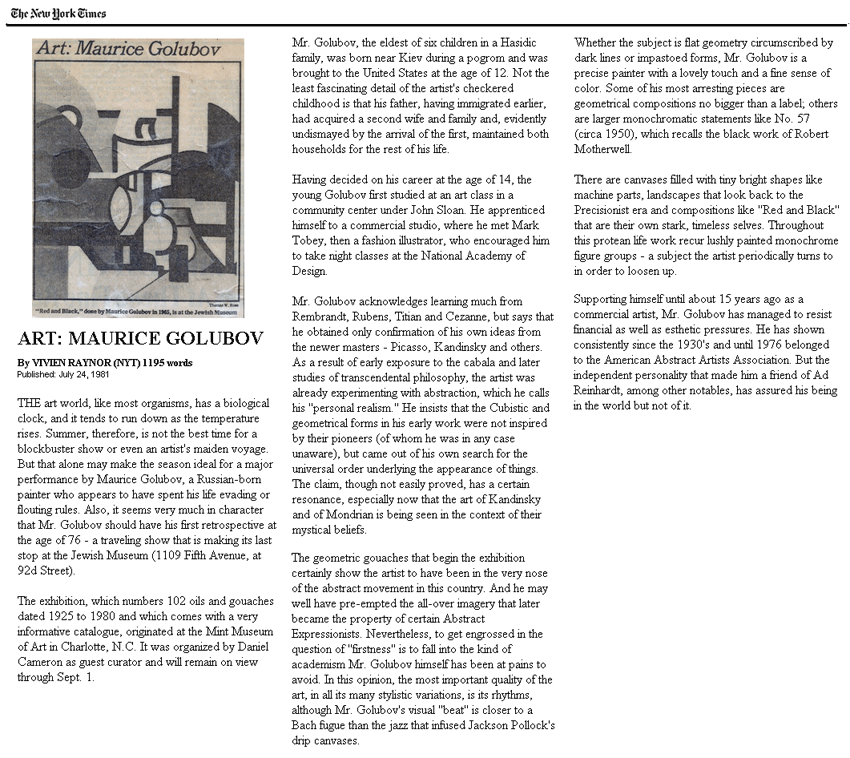This article was written by Viven Raynor and published in the New York Times, July 24, 1981.
THE art world, like most organisms, has a biological clock, and it tends to run down as the temperature rises. Summer, therefore, is not the best time for a blockbuster show or even an artist’s maiden voyage. But that alone may make the season ideal for a major performance by Maurice Golubov, a Russian-born painter who appears to have spent his life evading or flouting rules. Also, it seems very much in character that Mr. Golubov should have his first retrospective at the age of 76 – a traveling show that is making its last stop at the Jewish Museum (1109 Fifth Avenue, at 92d Street).
The exhibition, which numbers 102 oils and gouaches dated 1925 to 1980 and which comes with a very informative catalogue, originated at the Mint Museum of Art in Charlotte, N.C. It was organized by Daniel Cameron as guest curator and will remain on view through Sept. 1.
Mr. Golubov, the eldest of six children in a Hasidic family, was born near Kiev during a pogrom and was brought to the United States at the age of 12. Not the least fascinating detail of the artist’s checkered childhood is that his father, having immigrated earlier, had acquired a second wife and family and, evidently undismayed by the arrival of the first, maintained both households for the rest of his life.
Having decided on his career at the age of 14, the young Golubov first studied at an art class in a community center under John Sloan. He apprenticed himself to a commercial studio, where he met Mark Tobey, then a fashion illustrator, who encouraged him to take night classes at the National Academy of Design.
Mr. Golubov acknowledges learning much from Rembrandt, Rubens, Titian and Cezanne, but says that he obtained only confirmation of his own ideas from the newer masters – Picasso, Kandinsky and others. As a result of early exposure to the cabala and later studies of transcendental philosophy, the artist was already experimenting with abstraction, which he calls his ”personal realism.” He insists that the Cubistic and geometrical forms in his early work were not inspired by their pioneers (of whom he was in any case unaware), but came out of his own search for the universal order underlying the appearance of things. The claim, though not easily proved, has a certain resonance, especially now that the art of Kandinsky and of Mondrian is being seen in the context of their mystical beliefs.
The geometric gouaches that begin the exhibition certainly show the artist to have been in the very nose of the abstract movement in this country. And he may well have pre-empted the all-over imagery that later became the property of certain Abstract Expressionists. Nevertheless, to get engrossed in the question of ”firstness” is to fall into the kind of academism Mr. Golubov himself has been at pains to avoid. In this opinion, the most important quality of the art, in all its many stylistic variations, is its rhythms, although Mr. Golubov’s visual ”beat” is closer to a Bach fugue than the jazz that infused Jackson Pollock’s drip canvases.
Whether the subject is flat geometry circumscribed by dark lines or impastoed forms, Mr. Golubov is a precise painter with a lovely touch and a fine sense of color. Some of his most arresting pieces are geometrical compositions no bigger than a label; others are larger monochromatic statements like No. 57 (circa 1950), which recalls the black work of Robert Motherwell.
There are canvases filled with tiny bright shapes like machine parts, landscapes that look back to the Precisionist era and compositions like ”Red and Black” that are their own stark, timeless selves. Throughout this protean life work recur lushly painted monochrome figure groups – a subject the artist periodically turns to in order to loosen up.
Supporting himself until about 15 years ago as a commercial artist, Mr. Golubov has managed to resist financial as well as esthetic pressures. He has shown consistently since the 1930’s and until 1976 belonged to the American Abstract Artists Association. But the independent personality that made him a friend of Ad Reinhardt, among other notables, has assured his being in the world but not of it.
